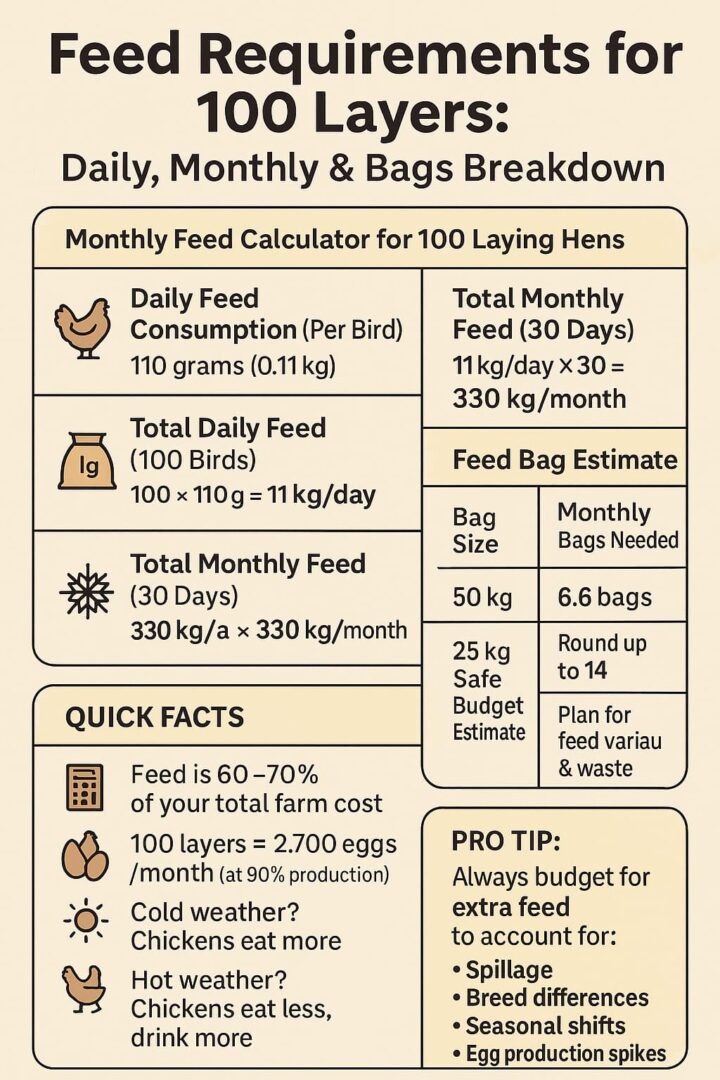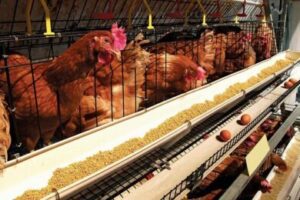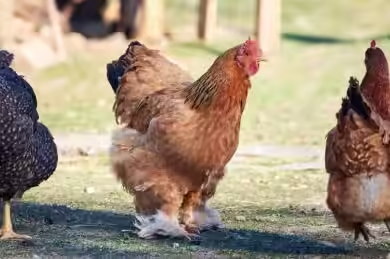Last updated on July 31, 2025
If you’re asking, “How much feed do 100 layers need per day?” you’re tackling the same question that almost put my small farm out of business. I was spending a fortune on feed, buying 14-15 bags a month, but it felt like half of it was ending up on the floor for rats to eat. My profits were shrinking.
But after months of trial and error, I cracked the code. I figured out how to feed my 100 layers with just 7-8 bags a month while keeping egg production over 85%.
This guide is my playbook. I’ll give you the quick calculators and charts first, then I’ll walk you through the exact steps I took—the mistakes I made, the changes that worked, and how you can apply my lessons to your own flock.
Layer Feed Quick Reference Chart
This chart immediately answers how many bags of feed you’ll need for different flock sizes, helping you plan at a glance.
| Flock Size | Feed Per Day (kg) | Bags Per Month (50kg) |
|---|---|---|
| 50 Layers | 5.5 – 6.3 kg | 3.5 – 4 bags |
| 100 Layers | 11 – 12.5 kg | 7 – 8 bags |
| 200 Layers | 22 – 25 kg | 13 – 15 bags |
| 1000 Layers | 110 – 125 kg | 66 – 75 bags |

How Much Feed for 100 Layers Per Day Calculator
Take the guesswork out of feed planning. Enter your flock size and local feed price to get an instant estimate of your daily feed needs and monthly costs.
Input 1: Number of Layers
Input 2: Cost Per 50kg Bag of Feed or 25GK Bag of Feed
Output 1: Estimated Feed Per Day (kg)
Output 2: Estimated Bags Per Month
Output 3: Total Estimated Monthly Feed Cost
Poultry Feed Calculator
Feed Needs for Mature Layers
Estimated Feed Results
Profitability Estimates (Monthly)
Feed Needs for Raising Chicks (0-18 Weeks)
Estimated Feed Results (0-18 Weeks)
The Core Calculation: How Much Feed Do 100 Layers Really Need?
The foundation of all layer feed calculations is the consumption of a single bird. A healthy, commercially-bred laying hen in her peak production phase (19-75 weeks) will consume approximately 110 to 125 grams of feed per day.
- 110g per bird/day: Typical during warmer weather or for highly efficient breeds.
- 125g per bird/day: Common in colder weather (as birds eat more to stay warm).
Based on this, here is the official breakdown for a flock of 100 layers:
| Timeframe | Total Feed Required (kg) | Equivalent in 50kg Bags |
|---|---|---|
| Per Day | 11 – 12.5 kg | ~1/4 of a bag |
| Per Week | 77 – 87.5 kg | ~1.5 – 1.75 bags |
| Per Month | 330 – 375 kg | 7 to 8 bags |
The Cost in Nigeria (2025 Estimate): With a 50kg bag costing between ₦13,000 and ₦15,000, your daily feed cost for 100 layers is roughly ₦2,860–₦3,750. This is the baseline number every farmer should know.
My Costly Mistakes: Why I Was Using 15+ Bags a Month
While the absolute biological minimum is around 8 bags, the realistic industry standard is 11-12 bags a month. So where were my extra 3-4 bags going? It came down to massive feed spillage and poor-quality feed that forced them to eat more for less nutrition.
Did Cheaper Feed Save Me Money?
I switched to a cheaper local feed, thinking I’d save money. My hens ate more, but laid less. Egg shells got thinner, and my cost per egg actually went up. Key Outcome: Cheap poultry feed is expensive in the long run. Quality matters for both egg-laying rate and feed usage.
Can You Just Cut Back on Feed Amount?
I tried reducing the amount in the feeders. The dominant hens ate first, the weaker ones missed out, and my laying rate dropped below 75%. Key Outcome: Underfeeding hurts flock health and egg yield. The daily feed requirement for layers is not negotiable if you want consistent production.
The 3 Changes That Cut My Feed Bill by 20%
I realized the key wasn’t about starving my birds; it was about being smarter. Here are the exact changes I implemented that made the biggest difference and got me down to just 7-8 bags a month.
1. Optimizing Feed Quality (Not Just Price)
- Use a reputable brand with 16–18% protein and high calcium (balanced layer ration Nigeria).
- Outcome: Stronger shells, better egg size, and higher laying rate.
2. Eliminating Feed Waste (The Feeder Fix)
This was a game-changer. I noticed so much feed on the floor… I switched to tube feeders and raised them to the birds’ back height. The result? I saved almost 2 full bags a month from spillage alone.
- Raise tube feeders to back height to avoid feed spillage.
- Only fill feeders two-thirds full—overfilling leads to more waste.
- Outcome: Less feed on the floor, fewer rats, and up to 2 bags saved per month.
3. Implementing Ruthless Tracking
- Record every bag, every day, in a simple notebook or app.
- Outcome: You’ll spot trends, catch problems early, and know your real cost per egg.
What Were My Real Results? (Before and After)
| Month | Feed Bags Used | Avg. Laying Rate | Eggs/Day | Feed Waste? |
|---|---|---|---|---|
| January | 14 | 77% | 77 | High |
| March | 7.5 | 85% | 85 | Low |
| April | 7 | 86% | 86 | Very Low |
Before:
- 14–15 bags/month for 100 layers
- Laying rate: 75–78%
- Lots of feed on the floor, thin shells, and stressed birds
After:
- 7–8 bags/month for 100 layers
- Laying rate: 83–87% (most days above 85%)
- Less feed waste, stronger shells, and a calmer flock
What Do Experts and Nigerian Farmers Say?
“Feed quality is the most important factor in egg production. If you cut corners on feed, you’ll see it in your egg numbers and your profit. Always use a balanced layer ration with enough protein and calcium.” — Dr. Ken Anderson, NC State University Source
“If you don’t keep records, you’re just guessing. You need to know how many eggs you’re getting, how much feed you’re using, and what your costs are. That’s the only way to know if you’re making money or losing it.” — Dr. Jacquie Jacob, University of Kentucky Source
“I used to lose a lot of feed to spillage and rats. Once I raised my feeders and started tracking, I saved almost two bags a month. My profit went up, and my birds looked healthier.” — Mr. Adewale, Ogun State (AgroNigeria TV)
My 3-Step System for Slashing Feed Costs (Your Action Plan)
Based on my experience, here is a simple plan you can follow to get your own feed consumption under control.
- Use the Right Feeders: Use tube or gravity feeders, not open trays. Place feeders at the height of the birds’ backs and check for leaks or holes. Sweep under feeders daily to monitor waste.
- Establish a Consistent Schedule: Feed at the same time every day. Hens thrive on routine.
- Ensure Constant Access to Clean Water: Provide clean, cool water at all times. Dehydration reduces feed intake and egg output.
- Manage Feed Spillage: Only fill feeders two-thirds full—overfilling leads to more waste. Store feed in airtight bins to keep out rats and moisture. This results in less spoilage, fewer pests, and more feed in your hens—not the bin.
- Monitor Your Flock: Cull or separate sick birds quickly as disease spreads fast and drags down flock performance. Monitor egg size and shell quality; small or thin-shelled eggs can signal feed or health problems. Keep the coop clean and dry as wet litter increases disease risk and reduces comfort.
Layer Feed Planning PDF
For easy reference on your farm, you can download our complete Layer Feeding Chart as a PDF. It includes daily, weekly, and monthly requirements for various flock sizes.
[Download the Layer Feeding Chart PDF]
Adapting Calculations for Nigeria, India, and Other Regions
While the daily consumption of a layer (110-125g) is a global standard based on chicken biology, the cost and availability of feed are highly local.
For Farmers in Nigeria: When using our calculator, input the current price of a 50kg bag of layers mash from your local supplier. As of 2025, prices from major suppliers often range from ₦13,000 to ₦15,000. Your primary goal is to find a quality feed with 16-18% protein. This section directly answers how much feed for 100 layers per day in Nigeria.
For Farmers in India: The principles are the same. Check local prices for a 50kg bag of layer feed (often ranging from ₹2,200 to ₹2,800 depending on the brand and state). The key ingredients like maize and soy are common, but local formulations may vary. This section directly answers how much feed for 100 layers per day in India.
For Farmers in South Africa: Layer feed prices can vary significantly by province and brand, typically ranging from ZAR 250-400 per 50kg bag. Key ingredients often include maize, soya, and sunflower oil cake. Always verify prices with local suppliers like Meadow Feeds or Nutri Feeds.
For Farmers in Ghana: A 50kg bag of layer mash in Ghana might cost anywhere from GHS 180-250, depending on the brand and current market conditions. Maize and soy are foundational ingredients, similar to other regions. Local feed mills are common, so checking directly with them is advisable.
For Farmers in the USA: Feed prices are highly regional and fluctuate based on commodity markets. A 50lb (approx. 22.7kg) bag of layer feed can range from $18-$30, meaning a 50kg equivalent would be roughly $40-$65. Major brands include Purina, Nutrena, and Kalmbach. Prices are often influenced by corn and soybean futures.
For Farmers in the UK: A 20kg bag of layer pellets or mash typically costs between £12-£20. For a 50kg equivalent, this would be around £30-£50. Popular brands include Allen & Page, Smallholder Range, and Marriages. Prices can vary based on organic certification and specific formulations.
For Farmers in Australia: A 20kg bag of layer pellets might range from AUD 25-40, translating to AUD 60-100 for a 50kg equivalent. Major suppliers include Laucke, Barastoc, and Ridley. Drought conditions or export demands can significantly impact local feed prices.
The key is to use the universal consumption metric (110-125g per bird) and apply your specific local costs.
Can I Mix My Own Feed for Layers?
If you want to mix your own feed, always use a proven formula from a university or extension service. Here’s a sample layer feed formula recommended by the University of Georgia Extension:
Sample Layer Feed Formula (per 100kg):
- Maize (corn): 52 kg
- Soybean meal: 18 kg
- Wheat offal (bran): 15 kg
- Fish meal: 5 kg
- Limestone: 8 kg
- Vitamin-mineral premix: 1 kg
- Salt: 0.5 kg
- Methionine: 0.25 kg
- Lysine: 0.25 kg
This formula provides a layer ration protein content of about 16–18%, which is ideal for high egg production and strong shells.
Source: University of Georgia Extension, Commercial Layer Production Guide, Table 7
Warning: If you get the balance wrong, you’ll see poor egg size, weak shells, and lower production. For most small farmers, buying a reputable commercial feed is safer and more cost-effective.
How Do I Handle Seasonal Drops in Egg Production?
Rainy Season & Harmattan
- Add light to maintain 14–16 hours/day. Hens need light to lay.
- Improve ventilation to reduce heat and humidity stress.
- Check for disease and keep the coop dry.
- Increase feed energy slightly in cold weather (harmattan).
Seasonal effects on egg production are real—expect a 5–10% drop in laying rate during extreme weather.
Beyond Feed Bags: Calculating Your Real Cost Per Egg
Knowing your bags per month is good, but knowing your feed cost per egg is what makes you a true professional. This is the ultimate metric for profitability.
The Manual Formula:
- Track total feed used per month.
- Count total eggs produced per month.
- Divide feed cost by eggs produced to get feed cost per egg.
- Add other costs (meds, labour, electricity) for true cost per egg.
Example (2025 Estimate):
- 7.5 bags × ₦14,000 = ₦105,000 feed/month (using average of 7-8 bags)
- 2,550 eggs/month (85 eggs/day × 30)
- Feed cost per egg: ₦105,000 ÷ 2,550 = ₦41.18
- Add ₦10,000 other costs = ₦115,000 ÷ 2,550 = ₦45.10 per egg
The Easy Way: Use the Calculator Our calculator not only estimates your monthly feed bags but can also help you project costs. By inputting your flock size and feed price, you can instantly see your estimated monthly expenses, which is the first step in calculating your cost per egg and overall profitability.
How Can I Improve Layer Feed Efficiency and Egg Production Rate?
Daily Management
- Feed at the same time every day. Hens thrive on routine.
- Provide clean, cool water at all times. Dehydration reduces feed intake and egg output.
Health & Flock Management
- Cull or separate sick birds quickly. Disease spreads fast and drags down flock performance.
- Monitor egg size and shell quality. Small or thin-shelled eggs can signal feed or health problems.
- Keep the coop clean and dry. Wet litter increases disease risk and reduces comfort.
Key Takeaways for Small Flock
- Quality feed pays off in egg numbers and shell strength.
- Feed waste is profit lost—fix your feeders and storage.
- Record-keeping is your best tool for improvement.
- Don’t panic at seasonal dips—adjust and monitor.
- Cull non-layers to keep your flock efficient.
Frequently Asked Questions (FAQ)
How much feed for 100 layers per day?
A flock of 100 layers needs between 11 kg and 12.5 kg of feed per day.
How many bags of feed for 100 layers per month?
You will need 7 to 8 bags (50kg each) of layer mash per month for 100 hens.
Is it cheaper to make my own layer feed?
It can be, but it’s risky. If the nutritional formula is wrong, egg production will drop, costing you more in the long run. For most small-scale farmers, a quality commercial feed is more reliable.
What happens if I underfeed my layers?
Underfeeding will cause a sharp drop in egg production, smaller egg sizes, and potential health issues. Consistency is key.
How do I handle production drops in the rainy season?
Add light, keep the coop dry, and check for disease.
How do I reduce chicken feed cost without hurting production?
Focus on feed quality, feeder design, and culling non-layers. Use a layers feed calculator to plan.
What is feed conversion ratio in poultry layers?
It’s the amount of feed needed to produce a certain number of eggs. Lower FCR means better efficiency.
What’s the real cost of egg production in Nigeria?
It’s the total of all your costs (feed, labor, meds, etc.) divided by the total number of eggs you produce. A good profitability calculator can help you estimate this number quickly by projecting your feed costs and revenue.
I didn’t get these results overnight. It took trial, error, and a lot of record-keeping. But if you want to feed 100 layers with 7-8 bags a month—and still get 85% production—it’s possible.
Start with quality feed, reduce waste, and track your numbers. Your wallet (and your hens) will thank you.
Have you tried any of these tips? Got your own story or question? Drop a comment below—I’d love to hear what’s working for you!


